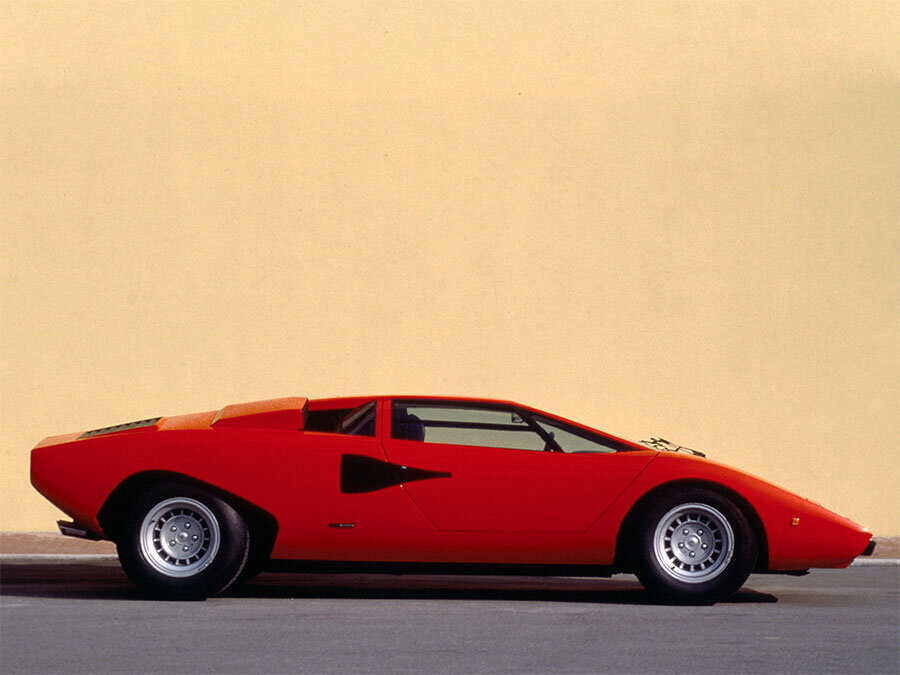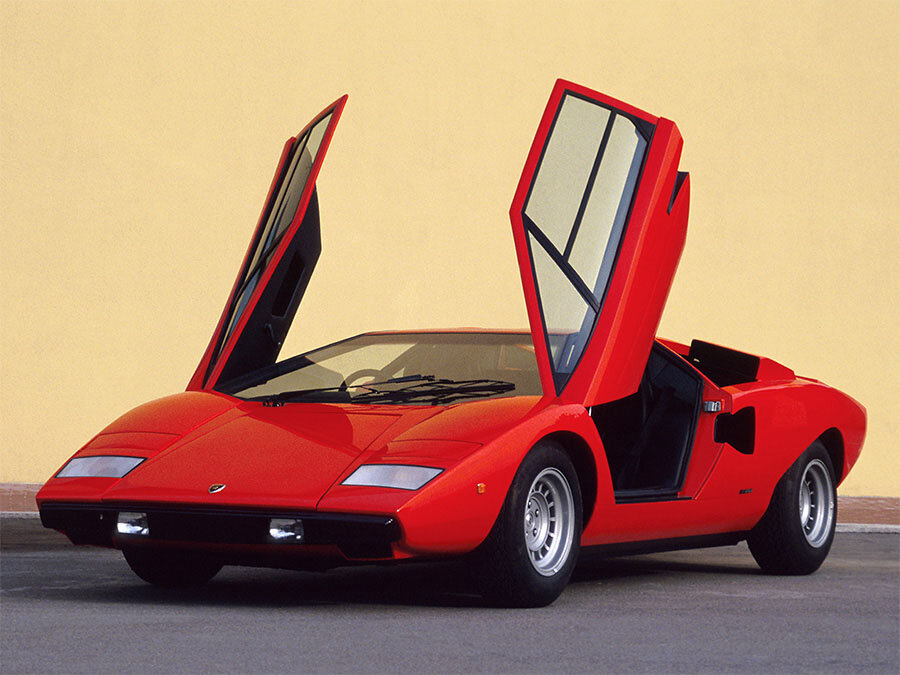Guide: New King - a Historical & Technical Appraisal of the Lamborghini Countach LP400
/Background
When the original Countach prototype was unveiled at the Geneva Motor Show in March 1971, many felt it would never see production. Their reasoning was sound; to refine such a radically packaged machine would prove an unprecedented technical challenge.
Naively, Lamborghini expected the development phase to last a few months. However, it was three long years before the first deliveries began.
Admirably though, the firm was not defeated in their quest to build arguably the most extraordinary looking motor car of all time.
There had been certain concessions to practicality and longevity, but to the casual observer, the production Countach LP400 was little changed from that first show car which had become such an overnight sensation.
Unfortunately for Automobili Lamborghini, the world had changed dramatically between 1971 and 1974.
The firm had begun the decade with an optimistic outlook. A new junior model called the Urraco was expected to bring a dramatic uptick in sales. Major investment in tooling and factory space was made as Lamborghini looked to challenge Ferrari and to a lesser extent, Porsche.
Disappointingly, the Urraco was late into production and proved a commercial flop.
Amid a worldwide financial crisis, political instability also began to negatively affect some of Lamborghini’s major markets, particularly the tractor division. Meanwhile, labour reforms in Italy meant trade unionised staff could no longer be laid off.
At his lowest ebb, in 1972, Ferruccio Lamborghini sold Lamborghini Trattori to SAME and 51% of Automobili Lamborghini to Swiss industrialist, Georges-Henri Rossetti.
Things worsened considerably when the energy crisis hit in late 1973 as Arab OPEC members announced an embargo on oil sales to the USA, UK, Canada, Japan and the Netherlands.
The embargo was a response to the USA's support for Israel in the Yom Kippur War where Egypt and Syria (with the support of other Arab nations) had begun a military campaign to regain Arab territories lost during the 1967 Six Day War (when Egypt, Syria and Jordan had been the aggressors).
Oil prices rose exponentially and remained at elevated levels for the next two years.
Demand for gas-guzzlers evaporated practically overnight.
Faced with financial oblivion, in 1974, Ferruccio Lamborghini sold the remaining 49% of his auto maker to Rossetti’s friend, Rene Leimer.
Against this backdrop of turmoil, the first Countach LP400s started to roll out of the factory.
Deliveries began in April 1974, one month after the first production-spec. machine had been displayed at Geneva.
Chassis
Unlike the original 1971 prototype (which had been built on a square-tubed steel chassis with aluminium sheets riveted in place), all subsequent Countach were built on round tubed spaceframes.
While the dimensions and layout were similar (including the 2450mm wheelbase), the new chassis was considerably more complex than the original. It was also stiffer and lighter, weighing 90kg instead of 107kg.
Countach chassis were fabricated by Marchesi & C. in Modena.
The floorpan was a mixture of fibreglass and steel. Fuel tanks with a combined capacity of 120-litres were located at the rear of each sill.
Suspension was fully independent all round. Double wishbones were fitted at the front with upper lateral links, reversed lower wishbones and upper and lower trailing arms at the back. Coil springs and telescopic Koni dampers were installed to each corner (two per side at the rear). Anti-roll bars were fitted at either end.
The 267mm diameter disc brakes were supplied by Girling and ran off a separate hydraulic system for each axle.
Campagnolo subtly reworked the prototype’s cast magnesium five-bolt wheels by adding larger holes to improve ventilation. While these production rims retained the 14-inch diameter of the originals, they were widened by half an inch at either end (to 7.5-inches front and 9.5-inches rear). Michelin XWX tyres were standard equipment.
Engine & Gearbox
One of the biggest problems Lamborghini faced with regard to the original prototype was the reliability and longevity of its Tipo L500 five-litre engine.
A highly experimental unit that was over 1000cc bigger than any previous Lamborghini engine, the L500 contained a large quantity of magnesium and had a rebuild interval of only 20,000 miles.
When the only complete engine blew in late 1971, cash-strapped Lamborghini temporarily shelved it in favour of the well-proven four-litre lump.
Still one of the best high performance engines around, in four-litre trim Lamborghini’s all-alloy 60° V12 displaced 3929cc thanks to a bore and stroke of 82mm and 62mm respectively.
As usual, chain-driven dual overhead camshafts were fitted, but whereas some late Miura SVs came equipped with dry-sump lubrication, all Countach engines ran a wet-sump system.
The Tipo L406 motor fitted to Countach LP400s had a compression ratio of 10.5:1 and six sidedraught Weber 45 DCOE carburettors. Ignition was via two coils and two Marelli distributors.
Peak output was 375bhp at 8000rpm and 269lb-ft at 5000rpm.
Transmission was via Lamborghini’s own five-speed gearbox and limited-slip differential. A single dry-plate clutch was sourced from Fichtel & Sachs.
Bodywork
As soon as testing began in earnest with the original five-litre prototype, it became apparent that feeding enough air to the engine was going to be difficult. To get around this, an air box was added to each sail panel and a NACA duct was carved out from each flank. Both solutions fed air to a pair of radiators that were now mounted transversely instead of longitudinally.
To improve visibility, small rear three quarter windows were added ahead of each air box.
The nose angle was made shallower to reduce the excessive front end downforce that caused instability under hard braking. The leading edge of the nose was also flattened and now incorporated a pair of Carello driving lights inset from a bank of vertical radiator cooling vanes.
Brake cooling ducts were added underneath the bumper.
Revised tail light clusters housed separate indicator, brake and reverse lenses within the original trapezoidal reflector.
Body panels were now formed entirely from aluminium.
The subtle LP400 redesign was executed by Bertone’s head stylist, Marcello Gandini, who had been responsible for creating the prototype.
Interior
Perhaps the most drastic changes were inside.
The prototype’s unreliable digital dash and on-board computer were ditched soon after testing began. So was the single spoke steering wheel.
In their place, production cars used analogue instruments and a conventional three-spoke steering wheel.
Eight Stewart-Warner gauges were housed in a boxed binnacle upholstered like the rest of the dash in brushed suede alcantara.
Large read outs for road and engine speed were flanked to to left by a volt meter and ammeter. To the right were the fuel and oil temperature gauges. Mounted in between the speedometer and rev counter were oil pressure and water temperature gauges.
A series of warning lights were located underneath the instrument binnacle. On the central control panel was the radio and the ventilation controls. The air-conditioning interface was located ahead of the open gate gear lever along with a series of rocker switches.
Lamborghini typically upholstered the seats, transmission tunnel, sills and upper rear bulkhead in leather.
In a nod to the prototype, the innovative periscope rear view mirror was retained.
Although generally much more practically appointed than the prototype, production cars still had fixed-back seats and side windows that could only be lowered a few inches. Cockpit space was also very tight for anyone over six feet tall.
Weight / Production
Thanks to the lighter chassis and aluminium instead of steel body panels, the Countach LP400 weighed 45kg less than the prototype (1275kg compared to 1320kg).
Top speed was a quoted 178mph and 0-62mph took just 5.7 seconds, making it one of the fastest road cars on the planet.
Prototypes
Prior to chassis 1120002 being displayed at Geneva in 1974, a pre-production prototype (chassis 1120001) had been shown at Geneva in March 1973 (painted red). Chassis 1120001 was then presented at Paris in October 1973 (this time painted green).
Production
150 Countach LP400s were built between April 1974 and mid 1978. Around 17 were right-hand drive.
Three LP400s were converted to become Countach Speciales. There was also one Countach Speciale muletto and one Countach Speciale prototype built at Dallara Automobili for Walter Wolf.
Production stopped to make way for the Speciale-inspired Countach LP400 S which was unveiled at the Geneva Motor Show in March 1978.
Text copyright: Supercar Nostalgia
Photo copyright: Lamborghini - https://www.lamborghini.com



































